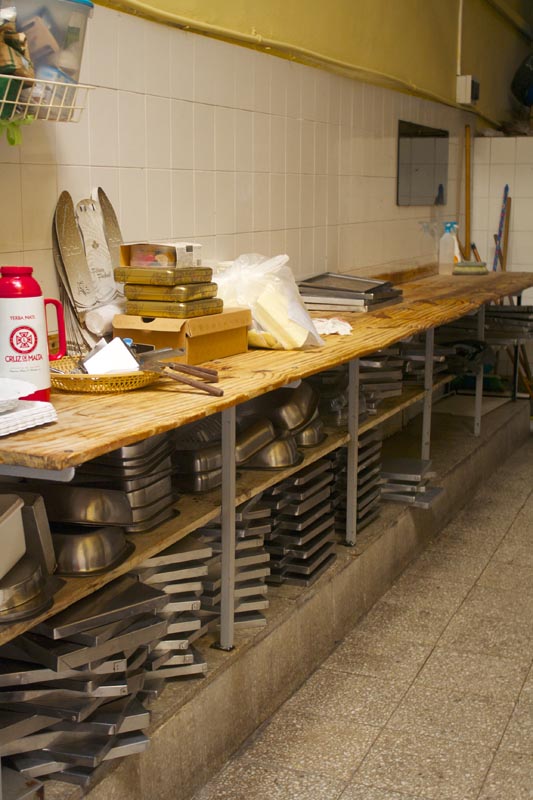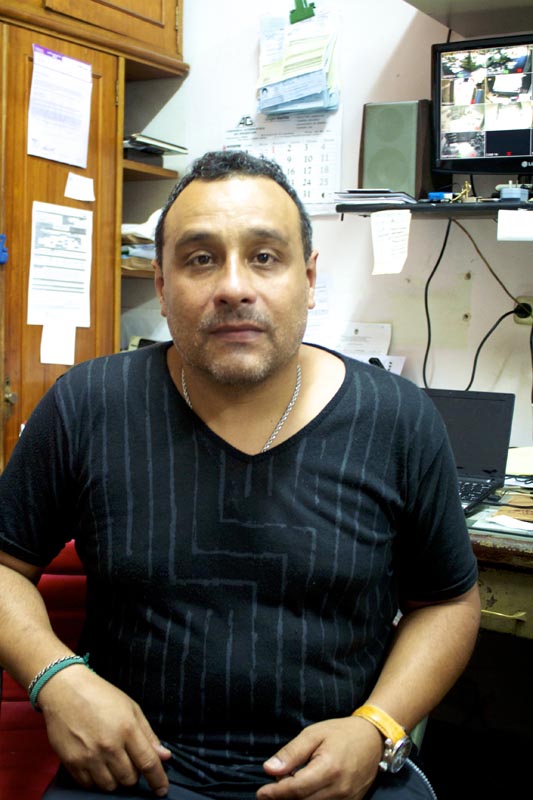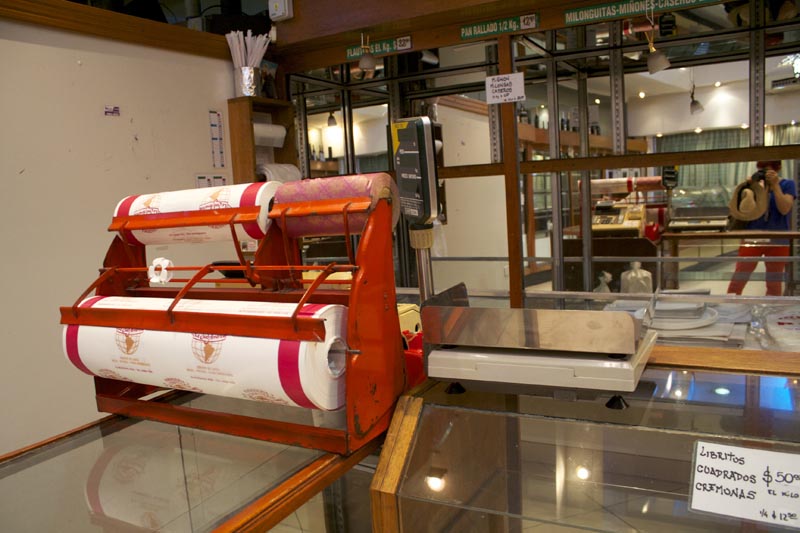January is just about the worst time to meet the owner of a bakery in Buenos Aires, or any business owner, for that matter.
Marcelo, the owner of La Sud América, a bakery in the Almagro neighborhood in Buenos Aires, was texting me with the news that he would be available for a brief meeting before he taking off for a holiday with his family. Like our summer months, Argentinian winters are prime vacation months for families with children out of school, which means that many businesses hang cerrado (closed) signs on their doors to indicate they are off for the holidays. So I was lucky to find to find a few minutes when Marcelo could show me around his small shop.

During the 19th century, Almagro was home to Italians and Basque families. As a haven for immigrants, the area also became home to the tango culture, built on the amalgamation of social customs and cultures.
Knowing that Marcelo would be anxious to escape the sweltering heat in the city, I located the shop and peered underneath the partially raised and profusely graffiti-covered metal door. He greeted me with a warm, Argentinian bear hug and led me to his office in back of the retail bakery shop. Marcelo wore flip-flops, baggy shorts, a black T-shirt, a silver necklace, and on one wrist, a huge sport watch with a yellow band and oversized, orange numerals. If his attire said anything, it said, “I’m not a baker today, just a guy wanting to be on a beach somewhere, looking cool.”

We moved beyond the retail shop, where wood and glass cases stood empty, worn labels revealing absent pastries and breads such as libritos and cremonas. A gleaming red paper cutter occupied an imposing position at the end of the counter to wrap purchases in white paper printed with the bakery’s decorative logo.
But the most impressive display in the small shop was the laminated article from Carghill News that had featured Marcelo and his bakery in 2007. There on the front page was Marcelo, holding a freshly baked loaf of bread in front of his old, brick oven. The antique oven is the main attraction of his small operation, built in the 1890s and one of the last remaining old brick ovens. (A famous bakery, L’Epi, located in Chacarita, has an oven built in 1919.) While boasting about its survival all these years, he complained about the annoyances that arose when bricks broke and he had to scour the city for hard-to-find replacements. Of course I wanted to see it, but for some reason Marcelo explained that it wasn’t available for viewing since the shop was closed. It didn’t make much sense to me, but who wants to push their luck when they have a shop owner who is technically on vacation offer to spend an afternoon explaining his business? Not me.
“Marcelo is an evangelist for the old way of baking bread.”
Marcelo is an evangelist for the old way of baking bread, and he makes much use of his brick oven. But despite the notoriety from the Carghill News, he’s not a big fan of Carghill flour. He reasoned that the company mixes grain from multiple growers and thus, in Marco’s opinion, the quality of the product varies from shipment to shipment, depending upon the mix from unknown sources. Instead, he buys from a smaller, Argentinian flour provider that purchases grains from a smaller and more familiar set of farmers.
One has to take this with a grain of salt, since the Argentinian government is in the midst of issuing tariff regulations and subsidies on a rather irregular and unpredictable basis. The country has been one of the largest exporters of wheat in Latin America, but recent bad weather has lowered production so that the grain harvest available for export after filling orders from Argentinian mills has rapidly declined. Even domestic mills are anxious about having enough grain to keep busy. All of these factors muddy Marcelo’s rationale for moving from Carghill to an Argentinian mill. He did explain that the mill gave him a “good” price because it liked the idea that Marcelo used the antique oven.
Marcelo led me from his empty shop to his back office, a rat’s nest of papers, dirty cups and empty soda bottles, shrink-wrapped boxes of paper goods, files and random items such as old, broken headphones amidst computers and closed-circuit security screens. The place was a mess, but Marcelo wanted me to believe he was in control of the apparent chaos as he half answered questions, holding the remote control for the air conditioning system in one hand and his cell phone in the other. Both were in operation at the same time.
But his attempt to appear in command failed when he was unable to locate the original copy of the Carghill article. He stepped out of his office to place a telephone call to his mother, who apparently has a mental map of all contents of Marcelo’s office. From the hallway, I could overhear his plea for help, which was proceeded by a plaintive “Mommy?” This tough baker, who owned not only this shop but also two bar/cafes, had suddenly become someone’s little boy.

He found the file, but in his enthusiasm for producing useful items from his files, he also pressed two books into my hands, explaining that they were old classics of his trade with recipes for traditional breads. These books, from the 1950s and ’60s, were at one time loved by some baker, and their pages were bent and soiled with butter and grease. Nothing like an old book to seal a friendship for life.
Marcelo never stopped walking, talking, texting, and moving the temperature up and down in the room from the remote control. He comes from a family of bakers, his father and grandfather working in bakeries in Buenos Aires, and he was quick to rattle off all the ingredients of the bread used to make chopàni sandwiches: wheat flour, margarine, salt, yeast, sugar. But he wasn’t as quick to respond to my question about the quantity of sandwich buns he makes every day. For a quick moment he put down his cell phone, picked up a calculator, and pronounced that he bakes about 900 sandwich loaves each day during the weekend and 650 to 700 on a weekday. Wouldn’t you think he knew how many loaves he bakes by now?
“His enthusiasm for the job bubbles to the top of our conversation.”
Perhaps his training as a lawyer, which he completed alongside his twin brother, prepared him more for negotiating with the bakers union than tallying production output. He showed disdain for the bakers’ union, which, he gleefully reported, he has eliminated from his business. Marcelo also revealed that the most unpleasant part of this job is working with his forty employees, whom he described as a big family who regularly bring him forty personal problems. On the bright side, Marcelo shared how much he enjoys the hands-on process of baking bread. He said he wants to be in the thick of day-to-day operations, admitting that he is a perfectionist (and maybe a micromanager). His enthusiasm for his job bubbles to the top of our conversation as he describes how important it is for him to work hard so that he can maintain to his family’s good reputation in the bakery business.
I imagined he was anxious to head to the beach with his family, so we wrapped up our conversation, walking by the towers of bright metal bread pans and pastry sheets on the way out. I really did want to see the old oven, but Marcelo was resistant to the last, saying that it was not that interesting when it wasn’t baking, which sounded like cover for other reasons. We’ll never know.

Author
The same sense of wonder that called Dr. Robyn Metcalfe to run the great deserts of the world has led her to take on the task of mapping our current food supply. A historian, desert distance runner and food futurist with a lifelong hunger to take on irrational challenges, Robyn Metcalfe marvels at what it takes to simply create a peanut butter and jelly sandwich.